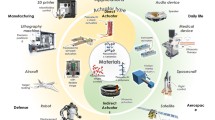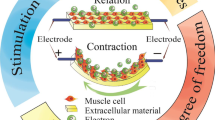Abstract
Stick–slip driving is widely applied because it provides a nearly infinite range of motion with sub-micron resolution, but its movement velocity is impacted by the dynamic response of high-voltage amplifiers. Therefore, this paper presents a high-voltage amplifier with a high dynamic response specific to stick–slip driving. Considering the capacitive load characteristic of stick–slip driving, an analog amplification circuit is designed to realize a high output voltage, and then a gate driving optimization method is proposed to improve the dynamic response performance of the amplifier. To verify the high dynamic characteristic of the voltage amplifier, an experimental system was built to test the dynamic response performance of the amplifier by monitoring the output voltage. The experimental results show that the gate driving optimization method improved the dynamic response performance by more than 10 times, and the amplifier can output an high dynamic voltage signal up to 150 V when driving a capacitive load of 0.5 μF.














Similar content being viewed by others
References
L.K. Barrett, T. Stark, J. Reeves, R. Lally, A. Stange, C. Pollock, M. Imboden, D.J.B. Ishop, A large range of motion 3D MEMS scanner with five degrees of freedom. J. Microelectromech. Syst. 28(1), 170–179 (2019). https://doi.org/10.1109/JMEMS.2018.2886653
C.H. Belussi, M.G. Berisso, Y. Fasanoa, Note: single-polarity high-voltage amplifier to drive coarse-approach slip-stick piezoelectric motors. Rev. Sci. Instrum. 84(5), 056104 (2013). https://doi.org/10.1063/1.4804166
L. Cheng, W.C. Liu, C.G. Yang, T.W. Huang, Z.G. Hou, M. Tan, A neural-network-based controller for piezoelectric-actuated stick-slip devices. IEEE Trans. Ind. Electron. 65(3), 2598–2607 (2018). https://doi.org/10.1109/TIE.2017.2740826
A.J. Fleming, A megahertz bandwidth dual amplifier for driving piezoelectric actuators and other highly capacitive loads. Rev. Sci. Instrum. 80(10), 104701 (2009). https://doi.org/10.1063/1.3234261
S.L. Jeng, Y.C. Tung, A multicell linear power amplifier for driving piezoelectric loads. IEEE Trans. Ind. Electron. 55(10), 3644–3652 (2008). https://doi.org/10.1109/TIE.2
J.I. Lee, X.H. Huang, P.B. Chu, Nanoprecision MEMS capacitive sensor for linear and rotational positioning. J. Microelectromech. Syst. 18(3), 660–670 (2009). https://doi.org/10.1109/JMEMS.2009.2016275
J.Y. Lee, W.C. Lee, Y.H. Cho, Serially connected weight-balanced digital actuators for wide-range high-precision low-voltage-displacement control. J. Microelectromech. Syst. 18(4), 792–798 (2009). https://doi.org/10.1109/JMEMS.2009.2023843
D. Marano, G. Palumbo, S. Pennisi, Step-response optimisation techniques for low-power, high-load, three-stage operational amplifiers driving large capacitive loads. IET Circuits Devices Syst. 4(2), 87–98 (2010). https://doi.org/10.1049/iet-cds.2009.0126
M. Miguez, J. Gak, A. Oliva, A. Arnaud, Active current mirrors for low-voltage analog circuit design. Circuits Syst. Signal Process. 36(12), 4869–4885 (2017). https://doi.org/10.1007/s00034-017-0650-2
A. Milecki, R. Regulski, Investigations of electronic amplifiers supplying a piezobimorph actuator. Mech. Syst. Signal Process. 78, 43–54 (2016). https://doi.org/10.1016/jymssp.2016.01.011
X.H. Nguyen, T.H. Mau, I. Meyer, B.L. Dang, H.P. Pham, Improvements of piezo-actuated stick-slip micro-drives: modeling and driving waveform. Coatings 8(2), 62 (2018). https://doi.org/10.3390/coatings8020062
R. Oubellil, A. Voda, M. Boudaoud, S. Regnier, Mixed stepping/scanning mode control of stick-slip SEM-integrated nano-robotic systems. Sens. Actuators A Phys. 285, 258–268 (2018). https://doi.org/10.1016/j.sna.2018.08.042
J.B. Qiu, K.K. Sun, T. Wang, H.J. Gao, Observer-based fuzzy adaptive event-triggered control for pure-feedback nonlinear systems with prescribed performance. IEEE Trans. Fuzzy Syst. (2019). https://doi.org/10.1109/TFUZZ.2019.2895560
N.A. Saadabad, H. Moradi, G. Vossoughi, Dynamic modeling, optimized design, and fabrication of a 2DOF piezo-actuated stick-slip mobile microrobot. Mech. Mach. Theory 133, 514–530 (2019). https://doi.org/10.1016/j.mechmachtheory.2018.11.025
M. Spiller, Z. Hurak, Hybrid charge control for stick-slip piezoelectric actuators. Mechatronics 21(1), 100–108 (2011). https://doi.org/10.1016/j.mechatronics.2010.09.002
K.K. Sun, S.S. Mou, J.B. Qiu, T. Wang, H.J. Gao, Adaptive fuzzy control for nontriangular structural stochastic switched nonlinear systems with full state constraints. IEEE Trans. Fuzzy Syst. 27(8), 1587–1601 (2018). https://doi.org/10.1109/TFUZZ.2018.2883374
H. Veldandi, R.A. Shaik, An ultra-low-voltage bulk-driven analog voltage buffer with rail-to-rail input/output range. Circuits Syst. Signal Process. 36(12), 4886–4907 (2017). https://doi.org/10.1007/s00034-017-0663-x
C.Y. Wang, Wide-dynamic-range and high-sensitivity current-to-voltage converters. Circuits Syst. Signal Process. 29(6), 1223–1236 (2010). https://doi.org/10.1007/s00034-010-9205-5
D.H. Wang, W. Zhu, Q. Yang, W.M. Ding, A high-voltage and high-power amplifier for driving piezoelectric stack actuators. J. Intell. Mater. Syst. Struct. 20(16), 1987–2001 (2009). https://doi.org/10.1177/1045389X09345559
B. W. Zhong, Z. H. Wang, T. Chen, L.G. Chen, L.N. Sun, The study on the effect of step time on the movement of the cross-scale stage based on the stick-slip driving, in 2013 IEEE International Conference on Manipulation, Manufacturing and Measurement on the Nanoscale (3 M-NANO), pp. 357–361 (2013). https://doi.org/10.1109/3M-NANO.2013.6737450
B.W. Zhong, J. Zhu, Z.Q. Jin, H.D. He, L.N. Sun, Z.H. Wang, Improved inertial stick-slip movement performance via driving waveform optimization. Precis. Eng. 55, 260–267 (2019). https://doi.org/10.1016/j.precisioneng.2018.09.016
Acknowledgements
The work was supported by the National Natural Science Foundation of China (No. 51875378), the National key research and development program (No. 2018YFB1304900), the Jiangsu province Natural Science Foundation (No. BK20181439) and the Suzhou science and technology development project (No. SYG201720). We thank the anonymous reviewers for their constructive comments and suggestions that improved this research.
Author information
Authors and Affiliations
Corresponding author
Additional information
Publisher's Note
Springer Nature remains neutral with regard to jurisdictional claims in published maps and institutional affiliations.
Rights and permissions
About this article
Cite this article
Zhang, D., Zhong, B., Jin, Z. et al. High-Voltage Amplifier with High Dynamic Response for Stick–Slip Driving. Circuits Syst Signal Process 39, 2759–2775 (2020). https://doi.org/10.1007/s00034-019-01289-6
Received:
Revised:
Accepted:
Published:
Issue Date:
DOI: https://doi.org/10.1007/s00034-019-01289-6




